Have you ever started weaving and realized that the fabric on the loom doesn’t look like the drawdown or picture?
That happened to Susan Palwick recently, so she posted pictures of her drawdown (draft #80355 from Handweaving.net) and her fabric on Facebook, and asked if anyone could help figure out what was happening.

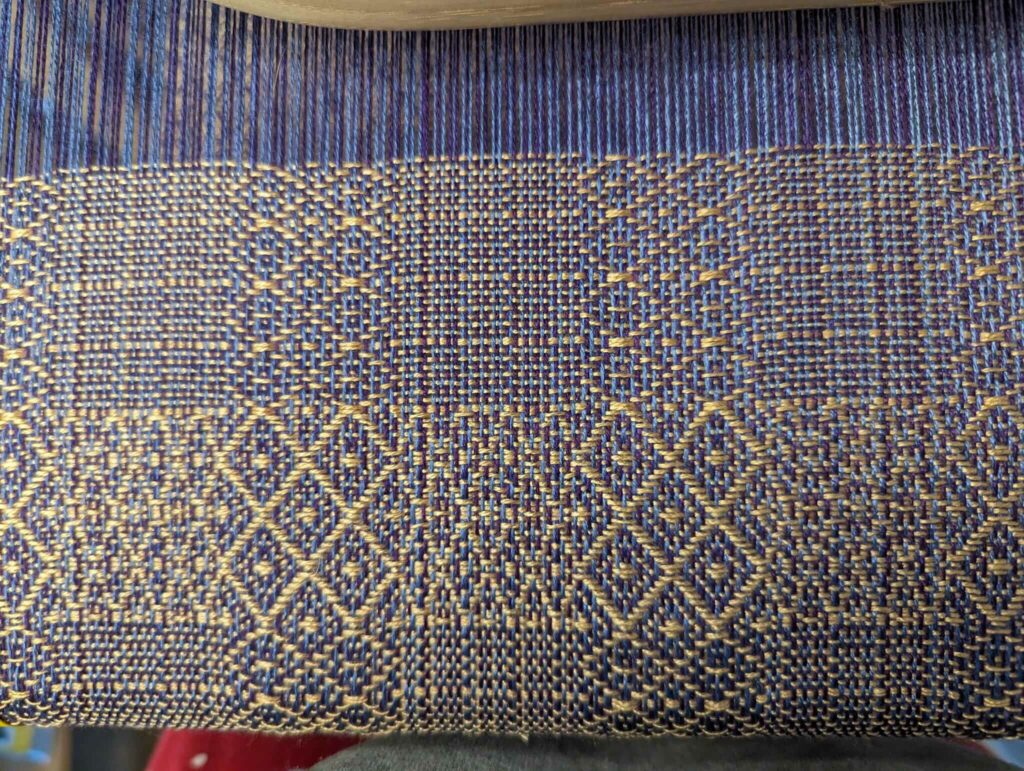
Most of the time when the cloth doesn’t match the drawdown, it’s because you’ve used a rising shed tie-up on a sinking shed loom or vice versa. All that’s happening in that situation is that the fabric is weaving upside down, with warp where you’d expect weft, and weft where you’d expect warp. You can “fix” that by changing the tie-up, but that isn’t really necessary because nothing’s really broken: as soon as you take the fabric off the loom and flip it over, all is well.
To see if this is your problem, simply look at the back side of the fabric! Alternately, if you have the draft open in drafting software
- look at the opposite side,
- switch the tie-up from rising shed to sinking shed or vice versa, or
- replace all the black or numbered squares in the tie-up with white squares and vice versa.
This works best if the draft is in the same colors you’re using on the loom, since that can confuse matters.
To show you what I mean, here are the two sides of the draft in Handweaving.net’s Draft Editor, now in Susan’s colors (which I did using Choose Colors from Image, also in the Draft Editor):


You can see that Susan’s fabric doesn’t look like the back side of the original draft either:

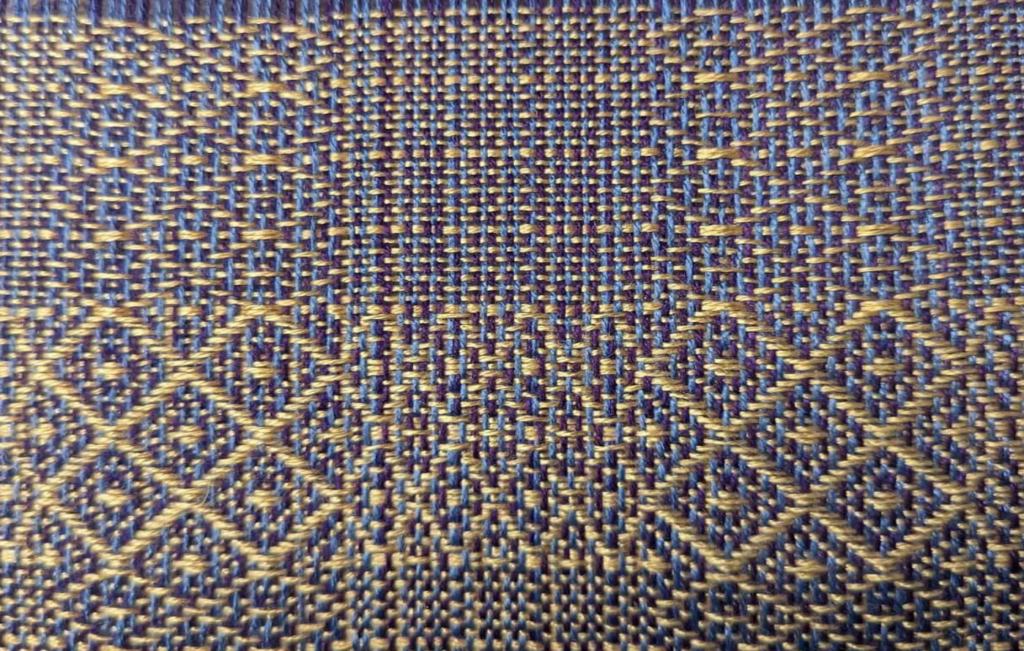
Not just an upside down tie-up
I could tell right away that this wasn’t Susan’s problem, because the motifs didn’t match. If the cloth was just upside down, she would have still seen the same diamonds in the same places, they’d just have been blue instead of gold or vice versa.
To see that the motifs don’t match, compare the original drawdown to Susan’s fabric:


The big diamonds in Susan’s fabric look similar to the drawdown but they’re not quite right somehow. The diamonds above and beside the big diamonds aren’t right either, and the small diamonds kitty-corner to the big ones are gone entirely:


So… what IS going on here if it isn’t simply that the cloth is weaving upside down?
The clue lies in the shape of the big diamonds.
Reversing the diagonals
Take a close look at the big, bold diamonds:


At first glance, it may look like drawdown and fabric match, but if you draw vertical and horizontal lines through the middle of each section…
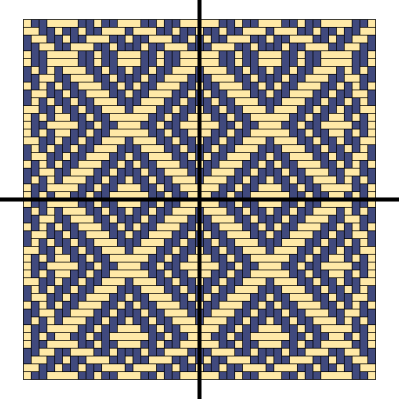
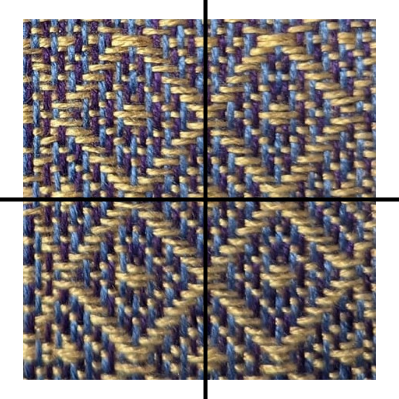
…you can see that the drawdown has an X (or “cross”) in each quadrant, whereas the blue and gold fabric has a diamond in place of the cross. The very center of the drawdown, where the vertical and horizontal lines intersect, is also a cross, whereas the lines intersect over a diamond in the fabric.
This was my clue to what happened to Susan’s draft.
I’m most used to seeing this kind of switch, from cross to diamond, in overshot. When you switch from star fashion to rose fashion, anything that was a cross becomes a diamond, and anything that was a diamond becomes a cross. (Stars also become roses and vice versa.)
What’s happening in the general case is that the direction of the diagonals is switching from / to \ and vice versa. That’s what’s happening in overshot when you go from star to rose, and what’s happening in twill when you go from cross to diamond.
To see what I mean, take a look at this cross, which is made up of four short diagonals…

…and look what happens if we take each individual piece of that cross and flip it horizontally:

Now we’ve got a diamond instead!
This is exactly what has happened to Susan’s big diamonds. The drawdown looks like this:


But the fabric looks like this:


So clearly the diagonals had reversed direction. But how did this happen??
Flipping a tie-up horizontally
As discussed at length in Cookies & Clocks and also several of the exercises in Angled Twills and Undulating Twills, you can reverse the direction of twill diagonals in one of three ways:
- By changing the direction that they’re threaded, or
- By changing the direction that they’re treadled, or
- By changing the direction of the diagonal in the tie-up.
Susan was sure that she’d threaded the loom correctly and that she was treadling following the draft, so all that was left was the tie-up.
Sure enough, if you take the original draft #80355 and flip its tie-up horizontally, you go from this…

…to this:

…and THAT looks like Susan’s fabric, right down to the missing diamonds in the top middle:


That’s the mystery of Susan’s fabric solved!
Flip or shift a twill tie-up for extra diamondy goodness
It’s useful to know how to recognize when the tie-up is flipped when you didn’t mean it to be, sure: it’ll save you some frustration at the loom, and that’s always a good thing! However, another take away here is that you can flip a twill tie-up horizontally or vertically to increase your design options. (Note that this applies to twill tie-ups; your mileage may vary for other structures, if it works at all.)
This will have the most impact if your twill design includes diamonds.
The above drawdowns show what happens to Draft #80355 when you flip the tie-up horizontally, which you can do by selecting Copy/Paste on the Tie-up menu, copying the existing tie-up, selecting the Flip ↔ checkbox, and then pasting the tie-up back into place. As we’ve seen, this will change the direction of the diagonals, and change any crosses into diamonds or vice versa.
You can also flip the tie-up vertically by doing much the same thing, except with the Flip ↕ checkbox selected instead. This will give you a slightly different result from flipping it horizontally. Crosses will still turn into diamonds, but they’ll be slightly different diamonds.
You can also copy the tie-up and paste it back into place, but shifted up or down by a shaft or two, or to the left or right by a treadle or two. In the Draft Editor, you need to have the Wrap ↑↓ checkbox selected for this to work. If you do this instead of flipping, your crosses will stay crosses and your diamonds will stay diamonds, but they’ll look different from before. If you do this in addition to flipping, your motifs will switch AND they’ll look different.
All in all, that gives you 16 new design options for any 8 shaft twill (or 24 for a 12 shaft twill, 32 for a 16 shaft twill, etc.) all without changing the length or arrangement of the floats in the tie-up.
Best of all, all these options can be had for the low, low price of re-tying the loom: no need to rethread, or even to learn a new treadling order! If you’ve put on a long warp and gotten into a groove with the treadling you’ve been using, you can change things up without having to change gears.
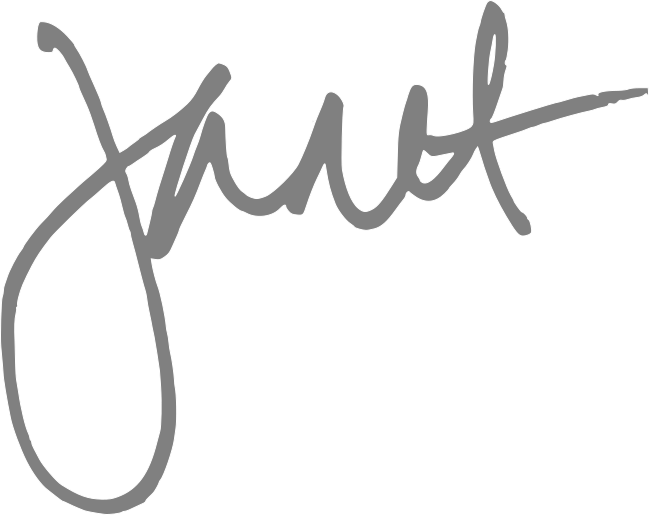
From the Course Catalog:

Spinning the Cookies from Designing in the Tie-Up with Cookies and Clocks – A look at the impact of straight threading and treadling direction on the motifs in the fabric.

Treadlings and Tie-ups for Undulating Twills from the course Undulating Twills – Exercises that demonstrate the impact of shifting and rotating the tie-up on a design.

Auditioning Twill Tie-ups from the course Angled Twills – More exercises in manipulating twill tie-ups to expand design options.

